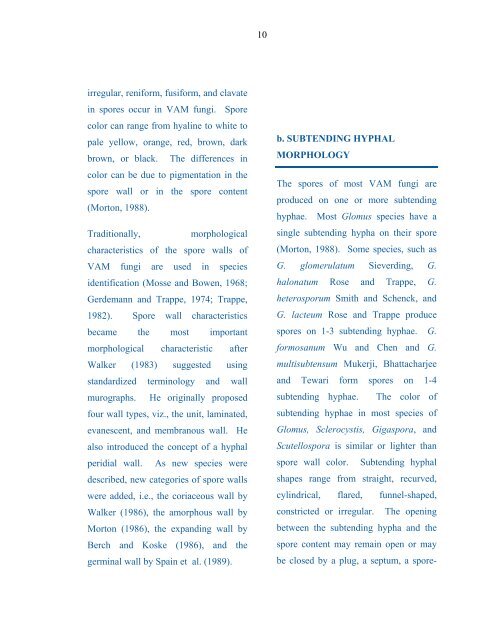Taxonomy and Ecology Of Inland Sand Dune ... - Mycorrhizae
Taxonomy and Ecology Of Inland Sand Dune ... - Mycorrhizae
Taxonomy and Ecology Of Inland Sand Dune ... - Mycorrhizae
You also want an ePaper? Increase the reach of your titles
YUMPU automatically turns print PDFs into web optimized ePapers that Google loves.
10irregular, reniform, fusiform, <strong>and</strong> clavatein spores occur in VAM fungi. Sporecolor can range from hyaline to white topale yellow, orange, red, brown, darkbrown, or black. The differences incolor can be due to pigmentation in thespore wall or in the spore content(Morton, 1988).Traditionally,morphologicalcharacteristics of the spore walls ofVAM fungi are used in speciesidentification (Mosse <strong>and</strong> Bowen, 1968;Gerdemann <strong>and</strong> Trappe, 1974; Trappe,1982). Spore wall characteristicsbecame the most importantmorphological characteristic afterWalker (1983) suggested usingst<strong>and</strong>ardized terminology <strong>and</strong> wallmurographs. He originally proposedfour wall types, viz., the unit, laminated,evanescent, <strong>and</strong> membranous wall. Healso introduced the concept of a hyphalperidial wall. As new species weredescribed, new categories of spore wallswere added, i.e., the coriaceous wall byWalker (1986), the amorphous wall byMorton (1986), the exp<strong>and</strong>ing wall byBerch <strong>and</strong> Koske (1986), <strong>and</strong> thegerminal wall by Spain et al. (1989).b. SUBTENDING HYPHALMORPHOLOGYThe spores of most VAM fungi areproduced on one or more subtendinghyphae. Most Glomus species have asingle subtending hypha on their spore(Morton, 1988). Some species, such asG. glomerulatum Sieverding, G.halonatum Rose <strong>and</strong> Trappe, G.heterosporum Smith <strong>and</strong> Schenck, <strong>and</strong>G. lacteum Rose <strong>and</strong> Trappe producespores on 1-3 subtending hyphae. G.formosanum Wu <strong>and</strong> Chen <strong>and</strong> G.multisubtensum Mukerji, Bhattacharjee<strong>and</strong> Tewari form spores on 1-4subtending hyphae. The color ofsubtending hyphae in most species ofGlomus, Sclerocystis, Gigaspora, <strong>and</strong>Scutellospora is similar or lighter thanspore wall color. Subtending hyphalshapes range from straight, recurved,cylindrical, flared, funnel-shaped,constricted or irregular. The openingbetween the subtending hypha <strong>and</strong> thespore content may remain open or maybe closed by a plug, a septum, a spore-


